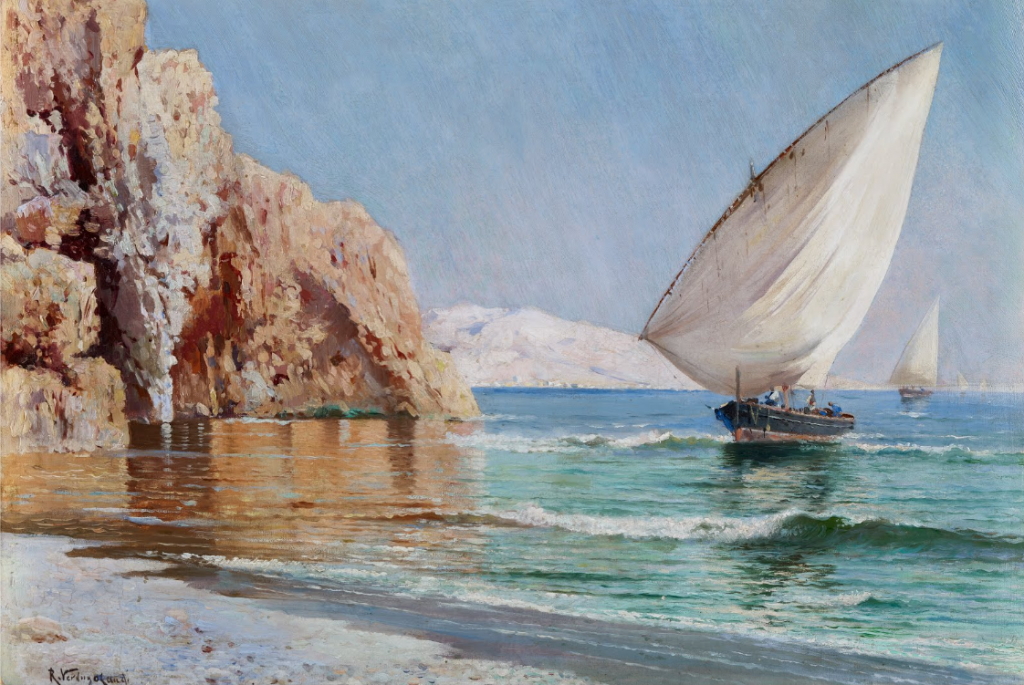Lesson Plans
Boats arriving
La llegada de las barcas
- Spain
- Water
- B1
Warming Up
Write at least 6 adjectives that describe the feeling you get when you see this piece of art (you can look up words in the dictionary).
Do you like it?
Could you tell what part of the world is just by looking at the picture?

Vocabulary
Cultural Heritage Background
React to statements by writing a T if the sentence is True or an F if the sentence is False.
The Phoenician civilisation came from what is now Syria and Lebanon. The people of this region had no choice but to move because their land was so dry it was impossible for them to grow food. When they arrived at what is now the “Costa del Sol” (south-west of Spain), they concentrated on activities at sea for they were excellent sailors. In fact, in the 6th century BC, Malaga became an important commercial centre in the Mediterranean.
The jábegas are part of Malaga’s history. The invention of these special boats dates back to the Phoenicians. At that time, these fast boats were used for trade and were the perfect vehicle for it, as traders and fishermen could go from one village to another in less than a day.
The Phoenicians spent a lot of time at the sea. That is why they prayed to Melkart, the sea god and protector of sailors. This is also why other cultures copied the Phoenician tradition of drawing an eye on both sides of their boats, which was believed to scare away sea monsters and pirates.
True or False
Listening
Listen to a sentence from the Cultural Heritage text and answer the following questions…
The jábegas are part of Malaga’s history. The invention of these boats dates back to the Phoenicians. At that time, these fast boats were used for trade and were the perfect vehicle for it, as traders and fishermen could go from one village to another in less than a day.
The Phoenicians spent a lot of time at the sea. That is why they prayed to Melkart, the sea god and protector of sailors. This is also why other cultures copied the Phoenician tradition of drawing an eye on both sides of their boats, which was believed to scare away sea monsters and pirates.
Listening Comprehension
Instructions: Listen to a sentence from the story and react to statements by writing a T if the sentence is TRUE or an F if the sentence is FALSE.
The traditional Málaga vessel (jábega) appears in Verdugo Landi’s painting “Boats Arriving”. The painting perfectly represents the paradise that is the “Costa del Sol”. Malaga, its capital, is one of the oldest cities in Europe and its history begins with the Phoenicians. In fact, Malaga became an important commercial centre in the Mediterranean during the 6th century BC.
Yet, the first ruins found in the “Costa del Sol” are older than the city of Malaga. Ruins from an abandoned city from the 4th century BC were found next to Malaga. These ruins show that floods caused by a tsunami destroyed this old city and forced people to move.
…Historians say that the Phoenicians thought that the gods punished humans with tsunamis when they did not respect the barrier between land and sea…
…”Jábegas” are proof that the Phoenicians’ lived in Malaga. This traditional boat appears in Verdugo Landi’s painting, the aesthetics of which scream “Mediterraneanism”
Reading the story
Move the paragraphs up and down to arrange them in the correct order and for the story to make sense.
Reading Comprehension
Read the story and react to statements by writing a T if the sentence is TRUE or an F if the sentence is FALSE.
Additional activities
- Vídeo (Australian English): History of the Phoenicians: The Maritime Superpowers of the Mediterranean
- Quiz: Phoenicians – Details – Kahoot!
Extra resources for learners
- Watch the video to learn how the tradition of building Jábegas is still alive in Málaga: Jábegas – The art of Malaga’s traditional fishing boats – YouTube
- Watch the documentary to learn more about Malaga: Malaga – La Costa del Sol
